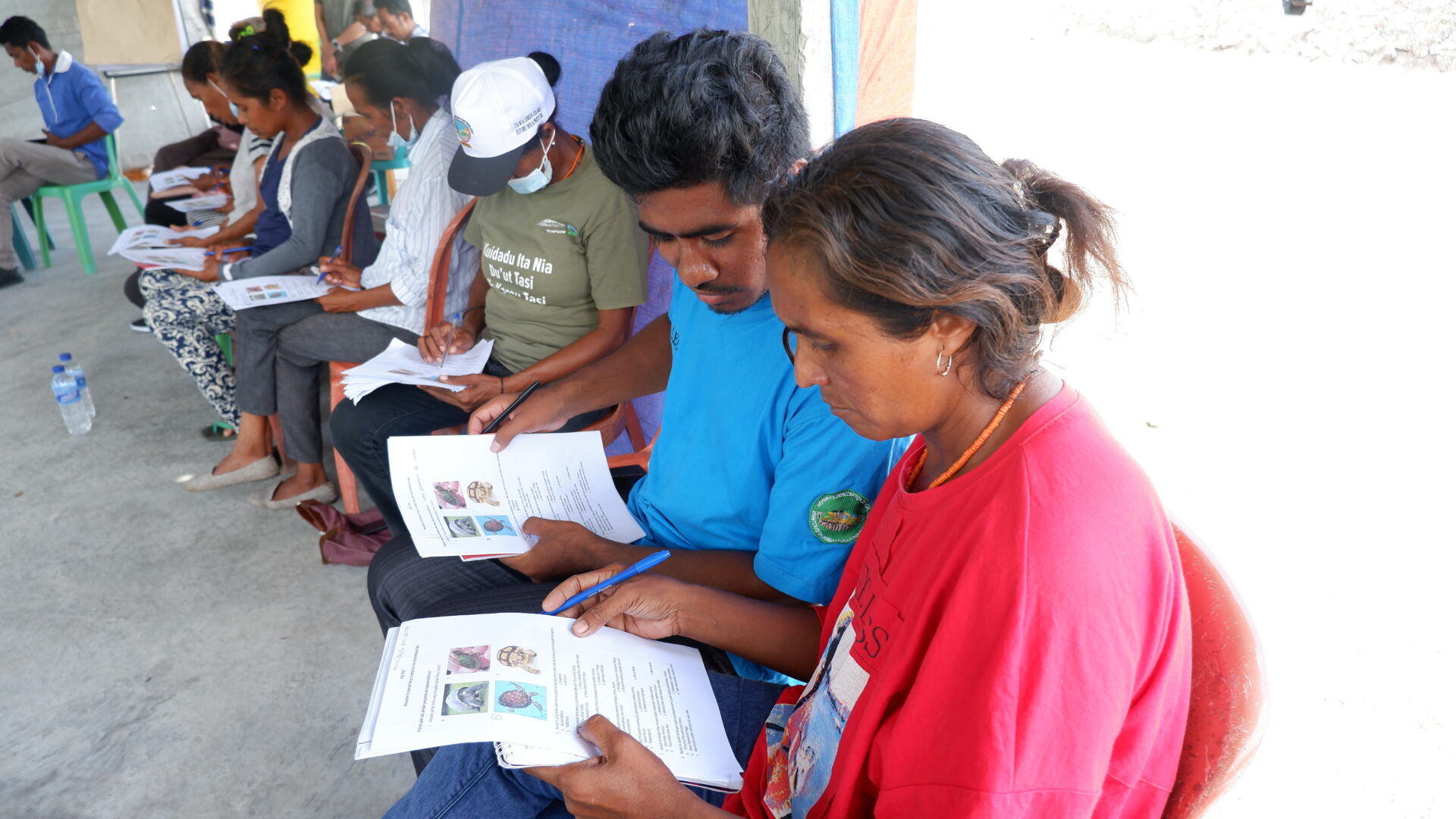For millions of years, sea turtles have played a vital role in maintaining the balance of marine habitats. However, populations have been dwindling in recent decades due to a combination of poaching, habitat destruction and bycatch. Evidence of this worrying decline can be seen in Com Village, Timor-Leste.
Com Village is part of Nino Konis Santana National Park – the first of its kind in Timor-Leste. Its beaches are recognised as important nesting sites for olive ridley, green and hawksbill turtles, while the surrounding ocean provides fertile breeding grounds for other marine wildlife, including dugongs. Communities here have been working together to address local threats and save populations of sea turtles.
Community-led Conservation on the Rise in Timor-Leste
In Com Village, the sea turtle population has been in decline, largely as a result of human activities – turtles are slaughtered for their meat, or their eggs are stolen from nesting sites. However, people are now beginning to wake up to this problem and take action.
Grupu Konservativu is part of a growing movement in the region, which is geared towards sea turtle conservation. Headquartered directly across from the beach in Com Village the group is made up of seven men and 26 women, who voluntarily undertake conservation initiatives to protect sea turtles in the local area.
Since 2009, Grupu Konservativu has been dedicating their time and energy to protecting sea turtles (referred to as ‘lenuk’ sea in the local -Tetun language). Specifically, they have been relocating sea turtle eggs to more secure locations, working in collaboration with and with guidance from conservation experts, so they can protect the eggs from human exploitation and predators.
Despite some progress over recent years, relocation efforts are yet to yield improvements to sea turtle populations at Com beach. Raul Pereira Mendes, the leader of the conservation group, revealed that hatching and release rates decreased by 80% when the group members tried to hatch the eggs in the same relocation nest. “The unhatched eggs often become smelly and surrounded by ants,” added Lucas Monteiro, the secretary of the conservation group. The decline they have witnessed in hatching rates offers a grim view of sea turtles’ future. But recently, thanks to interventions by ATSEA-2, there has been reason for optimism.
Sea Turtle Conservation Training with the ATSEA-2 Project Team

From 29–30 November 2022, Grupu Konservativu, together with various other local villages, attended a training session conducted by the ATSEA-2 Project. The training was hosted by Dwi Suprapti, a sea turtle expert who was able to shed light on turtle conservation methods and offer solutions to the problems being faced in local communities. Held over two days at the local conservation office, the training was facilitated by a local NGO called PROSPEK, appointed by the National Coordination Unit of Timor-Leste to support the Com community in their sea turtle conservation work.
The training represented a crucial first step towards sea turtle conservation in Com Village. Many additional developments will be required in future to help the group function to its optimum capacity: first and foremost, the group will need to apply for and obtain legal recognition; secondly, another training session related to sea turtle monitoring during nesting season would help to develop their understanding of nesting trends in Com; and third, a process of raising awareness and socialisation needs to be conducted, so that villagers in Com and neighbouring areas can understand that sea turtles are fully protected and cannot be harvested.
From the first day of the training, participants’ enthusiasm was clear to see. Suprapti revealed expert insights into the life of these ancient seafaring reptiles, demonstrating the various linkages between them and other organisms and processes within the ecosystem. In return, participants offered their undivided attention throughout the training, while also reaffirming their commitment to the conservation of marine turtles.
In one example, the secretary of the conservation group, Lucas Monteiro breathed a sigh of relief after it was confirmed that he needed to change the sand after the eggs hatched to avoid the growth of bacteria – the presence of bacteria can lower the hatching success rate, as explained by Suprapti. This was corroborated by the head of the conservation group, Raul Pereira Mendes, who had noticed in the course of their operations that if they used the same sand, it became slimy and resulted in a lower number of successful hatchlings.
Another member, Olderico Da Costa, said he learned that sea turtles play a vital role in the environment. He also clearly stated that he doesn’t see any benefit from exploiting sea turtles. “As a comparison, the price for 1kg fish is $40 and the price for 1kg sea turtle is $20-$30. So, selling sea turtles does not significantly increase family income,” Da Costa added.

In terms of future development, Grupu Conservativu plans to raise awareness of the protection of sea turtles within and beyond Com Village. They also hope to develop eco-tourism to provide economic benefits to the local community, along with sustainable funding for sea turtle conservation initiatives. To support this process, and as part of ATSEA-2’s wider commitments to facilitate community-led conservation in the ATS region, the Program will collaborate closely with PROSPEK in support of conservation groups in Com, so they can conserve and utilise their marine and coastal environment in a more sustainable way.
In addition, the Regional Biodiversity Specialist of the ATSEA-2 Project, Casandra Tania, highlighted that the training and other sea turtle-related activities in Com Village will contribute to the Regional Sea Turtle Action Plan for the ATS region that was endorsed by the four ATS countries last year. Specifically, the regional action plan highlights the need for building local capacity and encouraging community participation in conservation initiatives. “The training was the first out of many steps to show our commitment to the betterment of sea turtles in the region,” she explained.
By, Stella Yovita Arya Puteri, Yulia Dewi and Casandra Tania.
This article was published on GEF IW Learn.


